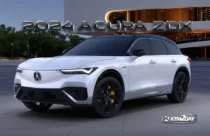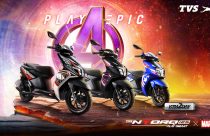Demystifying Hydrogen Cars: The Future of Emission-Free Driving?
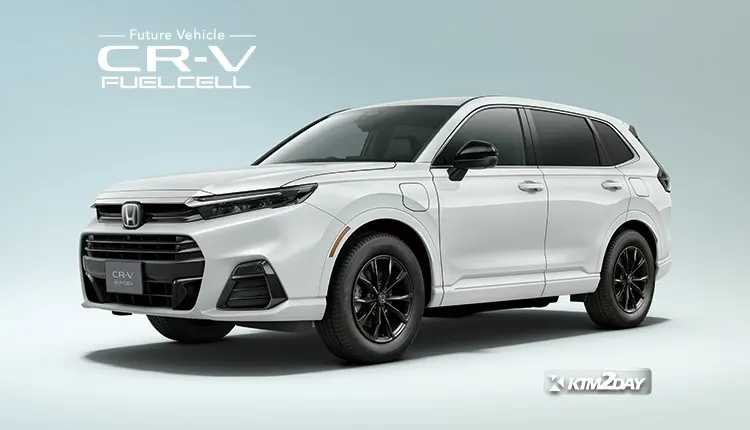

As the automotive industry continues its shift towards sustainable mobility, hydrogen fuel-cell vehicles (HFCVs) have emerged as a promising alternative to traditional gasoline-powered cars and battery-electric vehicles (BEVs). But what exactly are hydrogen cars, and how do they work?
An HFCV uses a fuel-cell stack to generate electricity from hydrogen gas, which powers an electric motor to turn the wheels, just like a BEV. However, instead of a large battery pack, the hydrogen is stored in high-pressure carbon-fiber tanks and combined with oxygen from the air to produce the electricity, with water vapor as the only emission.
This process essentially makes an HFCV a series hybrid, sometimes referred to as a fuel-cell hybrid electric vehicle (FCHEV). The driver’s experience is nearly identical to a BEV, with instant torque delivery, regenerative braking, and no need for a traditional transmission.
One of the key advantages of HFCVs is their refueling time, which takes only a few minutes, similar to a gasoline vehicle. Additionally, their range is typically over 300 miles, making them suitable for long-distance travel.

However, the current lack of a widespread hydrogen fueling infrastructure remains a significant hurdle for mainstream adoption. As of now, HFCVs are only available in select regions like California, where fueling stations are being gradually introduced.
This year, Honda will release the CR-V e:FCEV, a hydrogen-powered version of its popular compact SUV. Featuring a jointly developed fuel cell with GM and a 17.7 kWh battery pack for added electric range, the CR-V e:FCEV aims to offer a practical and efficient driving experience. However, with a projected annual volume of just 300 units and availability limited to California, it remains a niche offering for now.
While HFCVs are considered safe, with robust high-pressure tanks designed to withstand even the most severe crashes, their long-term viability will depend on the development of a comprehensive hydrogen production and distribution network.
As the world continues its transition towards sustainable transportation, hydrogen fuel-cell technology presents an intriguing emission-free solution, but its widespread adoption will hinge on overcoming the infrastructure challenges and achieving cost-competitiveness with BEVs and other alternative powertrains.
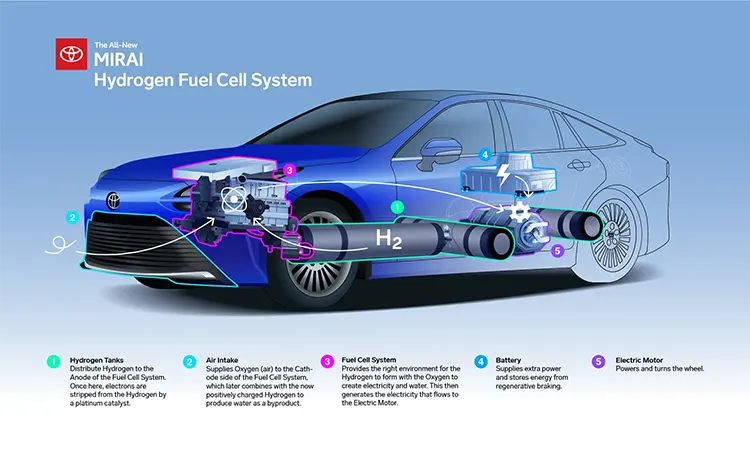
What is the difference between a hydrogen fuel-cell vehicle and an electric vehicle?
Hydrogen fuel-cell vehicles (FCVs) and electric vehicles (EVs) are both considered part of the broader category of “zero-emission vehicles” (ZEVs) because they produce little to no harmful emissions during operation. However, they operate on different principles and use distinct technologies to power their drivetrains. Here are the key differences between hydrogen fuel-cell vehicles and electric vehicles:
- Power Source:
- Hydrogen Fuel-Cell Vehicles (FCVs): FCVs use hydrogen gas as their primary fuel source. In a fuel-cell stack, hydrogen atoms are split into protons and electrons, generating electricity and producing water vapor as a byproduct. This electricity is used to power the vehicle’s electric motor.
- Electric Vehicles (EVs): EVs rely on electricity stored in batteries to power an electric motor. They can be charged from the electric grid or renewable energy sources like solar panels. EVs do not burn fuel internally; instead, they use stored electrical energy for propulsion.
- Energy Storage:
- Hydrogen Fuel-Cell Vehicles (FCVs): Hydrogen fuel is stored in high-pressure tanks onboard the vehicle. The fuel-cell stack then converts hydrogen into electricity to power the vehicle.
- Electric Vehicles (EVs): EVs use rechargeable batteries to store electrical energy. These batteries can be lithium-ion, nickel-metal hydride, or other types, depending on the vehicle model.
- Infrastructure:
- Hydrogen Fuel-Cell Vehicles (FCVs): FCVs require a specialized infrastructure for hydrogen production, transportation, and refueling stations. This infrastructure includes hydrogen production facilities (often from natural gas or renewable sources), storage facilities, and refueling stations.
- Electric Vehicles (EVs): EVs primarily rely on the existing electric grid infrastructure for charging. Charging options range from residential charging at home to public charging stations, fast chargers, and destination chargers at various locations.
- Range and Refueling/Recharging Time:
- Hydrogen Fuel-Cell Vehicles (FCVs): FCVs typically offer longer driving ranges compared to many battery-electric vehicles (BEVs). Refueling a hydrogen FCV can be comparable to refueling a gasoline vehicle in terms of time, taking a few minutes to fill the hydrogen tank.
- Electric Vehicles (EVs): EVs have varying ranges depending on the model and battery capacity, with some high-end models offering competitive ranges comparable to FCVs. Charging an EV can take longer than refueling a hydrogen FCV, especially with standard chargers, although fast-charging technologies are reducing this gap.
- Environmental Impact:
- Both FCVs and EVs are considered environmentally friendly compared to traditional internal combustion engine vehicles because they produce zero tailpipe emissions during operation. However, the overall environmental impact depends on factors such as the source of electricity (for EV charging) and the production method of hydrogen (for FCVs).
- Market Availability and Adoption:
- Hydrogen Fuel-Cell Vehicles (FCVs): FCVs are less common in the market compared to EVs. They are currently more prevalent in certain regions with developed hydrogen infrastructure, such as parts of Europe, Japan, and California in the United States.
- Electric Vehicles (EVs): EVs, especially battery-electric vehicles (BEVs), have seen rapid growth and adoption globally. Major automakers are investing heavily in EV technology, leading to a broader range of EV models and increasing charging infrastructure.
In summary, while both hydrogen fuel-cell vehicles and electric vehicles offer zero-emission transportation, they differ in terms of their power sources, energy storage methods, infrastructure requirements, range, refueling/recharging times, environmental impact, and market adoption. Each technology has its advantages and challenges, and their suitability depends on factors such as regional infrastructure, driving habits, and availability of renewable energy sources.
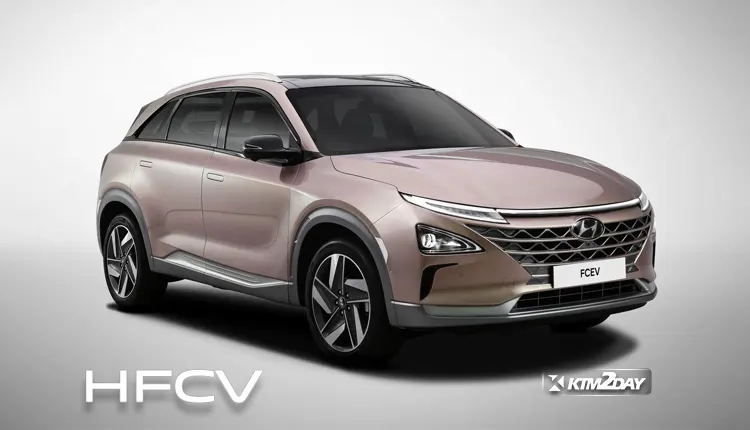
Current State of HFCV
Hydrogen fuel cell vehicles (HFCV) are an emerging technology that offers several advantages over conventional gasoline-powered vehicles and battery electric vehicles (BEVs). Here’s the current state of hydrogen fuel cell vehicle technology:
Availability and Models
A limited number of FCEV models are currently available, primarily in California which has the most developed hydrogen fueling infrastructure. The major models include:
- Toyota Mirai – Around 5,000 units sold since 2015
- Honda Clarity Fuel Cell – Nearly 1,100 units on U.S. roads
- Hyundai Nexo – Around 220 units on U.S. roads
- Honda CR-V e:FCEV (2024 model) – Projected volume of 300 units per year, only available in California
Other automakers like GM, Ford, and Fiat Chrysler are also exploring and investing in FCEV technology.

Advantages
- Zero tailpipe emissions, only water vapor is emitted
- Longer driving range (300-400 miles) than most current BEVs
- Faster refueling time (3-5 minutes) compared to BEV charging
- High energy efficiency and performance comparable to gasoline vehicles
- Qualify for incentives like carpool lane access and rebates in some regions
Challenges
- Limited hydrogen fueling infrastructure, with only around 60 public stations in California
- High costs and limited production volumes currently
- Concerns over emissions from hydrogen production using fossil fuels
- Safety concerns and infrastructure challenges still need to be addressed
Overall, hydrogen fuel cell technology is progressing, with automakers investing in it as a potential long-term solution for zero-emission vehicles. However, the lack of widespread fueling infrastructure remains a significant barrier to mainstream adoption currently.









